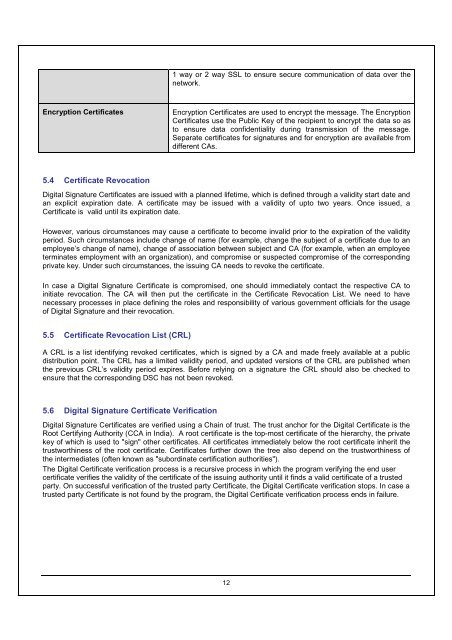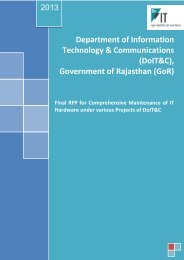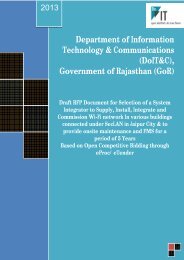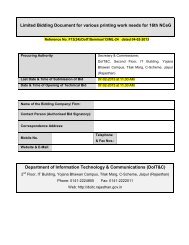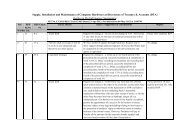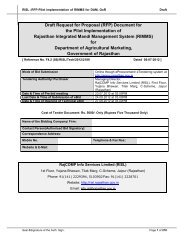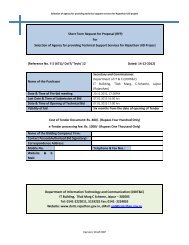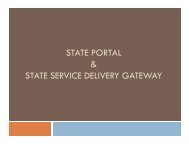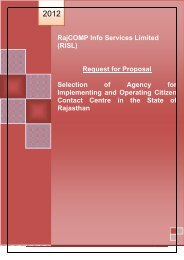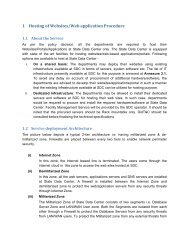Guidelines for Usage of Digital Signatures in e-Governance
Guidelines for Usage of Digital Signatures in e-Governance - DOIT & C
Guidelines for Usage of Digital Signatures in e-Governance - DOIT & C
Create successful ePaper yourself
Turn your PDF publications into a flip-book with our unique Google optimized e-Paper software.
1 way or 2 way SSL to ensure secure communication <strong>of</strong> data over the<br />
network.<br />
Encryption Certificates<br />
Encryption Certificates are used to encrypt the message. The Encryption<br />
Certificates use the Public Key <strong>of</strong> the recipient to encrypt the data so as<br />
to ensure data confidentiality dur<strong>in</strong>g transmission <strong>of</strong> the message.<br />
Separate certificates <strong>for</strong> signatures and <strong>for</strong> encryption are available from<br />
different CAs.<br />
5.4 Certificate Revocation<br />
<strong>Digital</strong> Signature Certificates are issued with a planned lifetime, which is def<strong>in</strong>ed through a validity start date and<br />
an explicit expiration date. A certificate may be issued with a validity <strong>of</strong> upto two years. Once issued, a<br />
Certificate is valid until its expiration date.<br />
However, various circumstances may cause a certificate to become <strong>in</strong>valid prior to the expiration <strong>of</strong> the validity<br />
period. Such circumstances <strong>in</strong>clude change <strong>of</strong> name (<strong>for</strong> example, change the subject <strong>of</strong> a certificate due to an<br />
employee’s change <strong>of</strong> name), change <strong>of</strong> association between subject and CA (<strong>for</strong> example, when an employee<br />
term<strong>in</strong>ates employment with an organization), and compromise or suspected compromise <strong>of</strong> the correspond<strong>in</strong>g<br />
private key. Under such circumstances, the issu<strong>in</strong>g CA needs to revoke the certificate.<br />
In case a <strong>Digital</strong> Signature Certificate is compromised, one should immediately contact the respective CA to<br />
<strong>in</strong>itiate revocation. The CA will then put the certificate <strong>in</strong> the Certificate Revocation List. We need to have<br />
necessary processes <strong>in</strong> place def<strong>in</strong><strong>in</strong>g the roles and responsibility <strong>of</strong> various government <strong>of</strong>ficials <strong>for</strong> the usage<br />
<strong>of</strong> <strong>Digital</strong> Signature and their revocation.<br />
5.5 Certificate Revocation List (CRL)<br />
A CRL is a list identify<strong>in</strong>g revoked certificates, which is signed by a CA and made freely available at a public<br />
distribution po<strong>in</strong>t. The CRL has a limited validity period, and updated versions <strong>of</strong> the CRL are published when<br />
the previous CRL’s validity period expires. Be<strong>for</strong>e rely<strong>in</strong>g on a signature the CRL should also be checked to<br />
ensure that the correspond<strong>in</strong>g DSC has not been revoked.<br />
5.6 <strong>Digital</strong> Signature Certificate Verification<br />
<strong>Digital</strong> Signature Certificates are verified us<strong>in</strong>g a Cha<strong>in</strong> <strong>of</strong> trust. The trust anchor <strong>for</strong> the <strong>Digital</strong> Certificate is the<br />
Root Certify<strong>in</strong>g Authority (CCA <strong>in</strong> India). A root certificate is the top-most certificate <strong>of</strong> the hierarchy, the private<br />
key <strong>of</strong> which is used to "sign" other certificates. All certificates immediately below the root certificate <strong>in</strong>herit the<br />
trustworth<strong>in</strong>ess <strong>of</strong> the root certificate. Certificates further down the tree also depend on the trustworth<strong>in</strong>ess <strong>of</strong><br />
the <strong>in</strong>termediates (<strong>of</strong>ten known as "subord<strong>in</strong>ate certification authorities").<br />
The <strong>Digital</strong> Certificate verification process is a recursive process <strong>in</strong> which the program verify<strong>in</strong>g the end user<br />
certificate verifies the validity <strong>of</strong> the certificate <strong>of</strong> the issu<strong>in</strong>g authority until it f<strong>in</strong>ds a valid certificate <strong>of</strong> a trusted<br />
party. On successful verification <strong>of</strong> the trusted party Certificate, the <strong>Digital</strong> Certificate verification stops. In case a<br />
trusted party Certificate is not found by the program, the <strong>Digital</strong> Certificate verification process ends <strong>in</strong> failure.<br />
12


